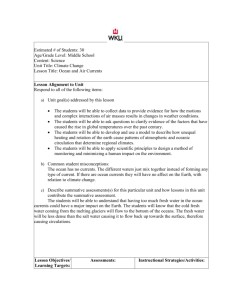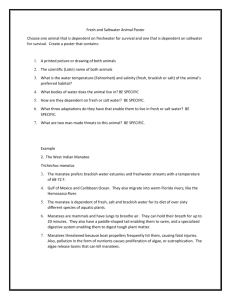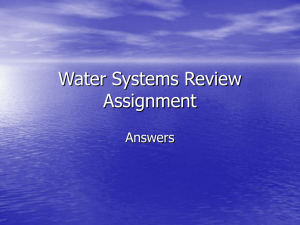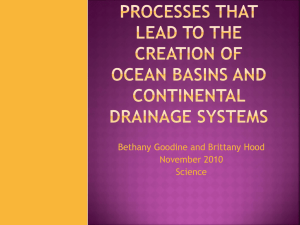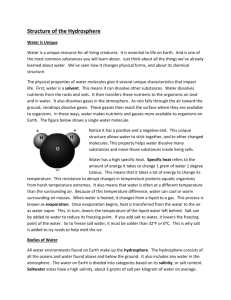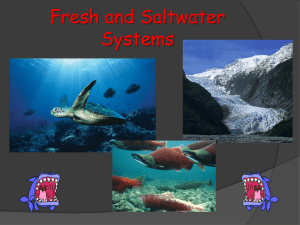Grade 8 Science
advertisement
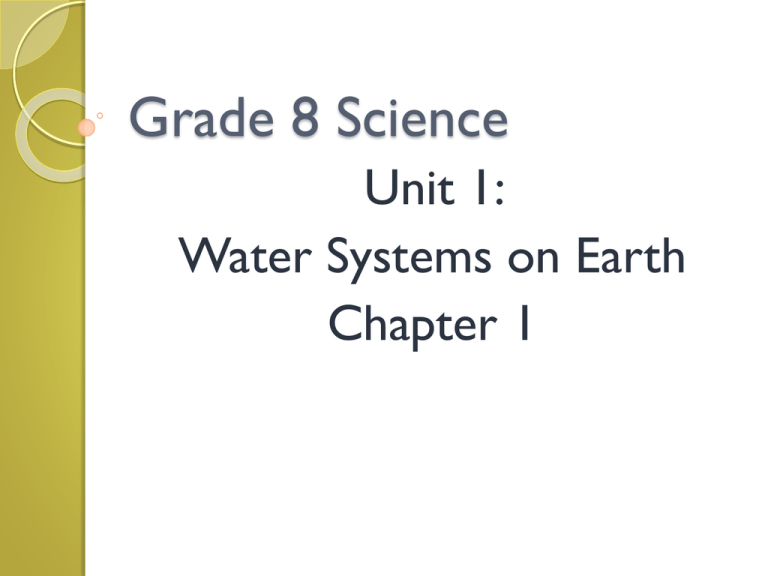
Grade 8 Science Unit 1: Water Systems on Earth Chapter 1 Effects of Water? Churchill River Large Ocean Wave How do you use water? House Hold Use Personal Use Recreational Activities Water Distribution Only 3% of the Earth’s water is fresh water (no salt). 2/3 of this water is frozen in ice sheets. Therefore only 1% of the fresh water on Earth is available. Review of Terms... Definition of Lithosphere: the solid rocky ground of the Earth’s crust. Do not write in pamphlet Atmosphere: the environment surrounding the Earth. Do not write in pamphlet Hydrosphere: All water on Earth. Including that in the lithosphere and atmosphere. Scientists who study water... Hydrologist A person who studies Earth’s water systems and helps to find solutions to problems of water quality and quantity. Not in pamphlet Oceanographer: A person who studies all aspects of the ocean. They are concerned with the biology, geology, physics, and mathematics of the ocean. Why do We Not Run Out of Water?? Because of the: WATER CYCLE The Water Cycle... The constant cycling of water through the processes of : Evaporation&Condensation.condensa tio Water is constantly changing from (gas liquid) and back again. This driven by the sun’s energy. Ocean Water vs. Fresh Water Three ways in which fresh water differs from ocean water are: 1. Salinity 2. Density 3. Freezing point 1. Salinity - Definition -The amount of salt dissolved in a specific amount of water. salt saltcomes comesfrom from dissolved dissolvedsolids solidsininthe the ground groundand andvolcanoes. volcanoes. Fresh Water has tiny amounts of salt. Salt Water Average amount of salt in salt water is 35 ppt. Salt content varies depending on location. Increase salt at the equator and poles 2. Density - Definition -The amount of mass of a substance in a certain unit volume. *How tightly packed together the material is in a substance. *Ocean water is more dense than fresh water due to the salt content. The Dead Sea 3. Freezing Point -Definition -The temperature at which a liquid freezes. Fresh water... 0oC *Salt water... -1.9oC * Core Lab Activities Activity 1-3A “Salinity’s Effect on Water Density” Graphing Assignment pp60-61 “Temperature & Water Density” Sources of Fresh Water 1. 2. 3. 4. 5. 6. Lakes, ponds and wetlands Streams and rivers Ground water Run Off Glaciers Drainage Basins 3. Ground Water... Precipitation that falls on land and sinks out of sight. Sinks through pores in rocks and goes down to bedrock where it pools. These pools to us make up “wells”. Ground Water : Drilling Wells 4. Run Off doesn’t sink into the ground or evaporate.: flows on land. is affected by: a) ground material, b) amount of rain, c) amount of time it rains, d)slope (steepness) of the land, e)vegetation, f) the amount of development. 5.Glaciers... A moving mass of snow and ice. Found in areas where it is so cold the snow remains all year. Glaciers in mountains and on the continent of Antarctica Glaciers slow down the Water Cycle by storing big amounts of frozen fresh water. Some water thaws in the hot summer months. They give us information about the Earth’s past climates. ( samples) Water trapped in glacial ice 6. Drainage Basins The Ice Age The most recent began 120 000 years ago ending 11 000 years ago. Glaciers covered ~ 20% of land on Earth. Glaciers and Global Warming In the last 100 years the average surface temp. Has increased by 0.5oC. The world’s glaciers are melting at a quicker paces than ever before. Melting Greenland Glacier Receding Athabasca Glacier in Alberta It has receded 1.5 km since 1843. What does this mean? Ocean waters may rise Flood rivers If they disappear, rivers may dry up. 6.Drainage Basins Watersheds The area of land with water that drains into a body of water such as a river, pond, lake or ocean. There may be many smaller basins within a larger basin. A divide separates one basin from another. For example: The Continental Divide Canadian Drainage Basins Drainage basins close to home are Labrador Sea, & Gulf Of St. Lawrence 6 Major Drainage Basins in NL 1. 2. 3. 4. 5. 6. Labrador Sea Gulf of St. Lawrence West Coast Gulf of St. Lawrence South Coast Gulf of St. Lawrence Atlantic Ocean Avalon Peninsula Atlantic Ocean North-east Coast One Component Affects Another Salinity : affects the types of organisms that can survive in an area. Eg. Dead Sea Temperature : affects the amount of dissolved oxygen in water. Ex. The higher the temp. the more oxygen. The convergence of the Labrador Current and the Gulf Stream Current (place where they meet) influences productivity of the Grand Banks (more fish there), the movement of icebergs, and migration of capelin and whales.



